My family recently spent around two weeks in Ireland.
It’s not a destination that many families have on the top of their bucket lists, but with castles, farms, fairy trails, beautiful coastal scenery, unique cities, and some beer and whiskey for the adults, there’s certainly something for everyone.
This was a trip we had originally planned for 2020, so it was nice to be able to finally go after postponing it for the pandemic. Since my parents and sister also joined us, there were some challenging booking and trip planning logistics involved.
Let’s take a look at how I approached planning the trip for the entire family.
The Destination
Ireland is a large island off the coast of the United Kingdom.
The southern and larger part of Ireland, the Republic of Ireland, is its own sovereign country and is part of the European Union. The smaller, northern part, Northern Ireland, is part of the United Kingdom.
Currently, there are no border restrictions for crossing between the two territories on the island. If you plan on travelling to both parts, consider bringing both euros and British pounds.
The land is divided into 26 counties in the south and six counties in the north. You’ll find a mix of small towns and cities throughout the counties, each being unique in its own way.
Between the counties are stretches of gorgeous green landscapes, with attractions spread throughout.
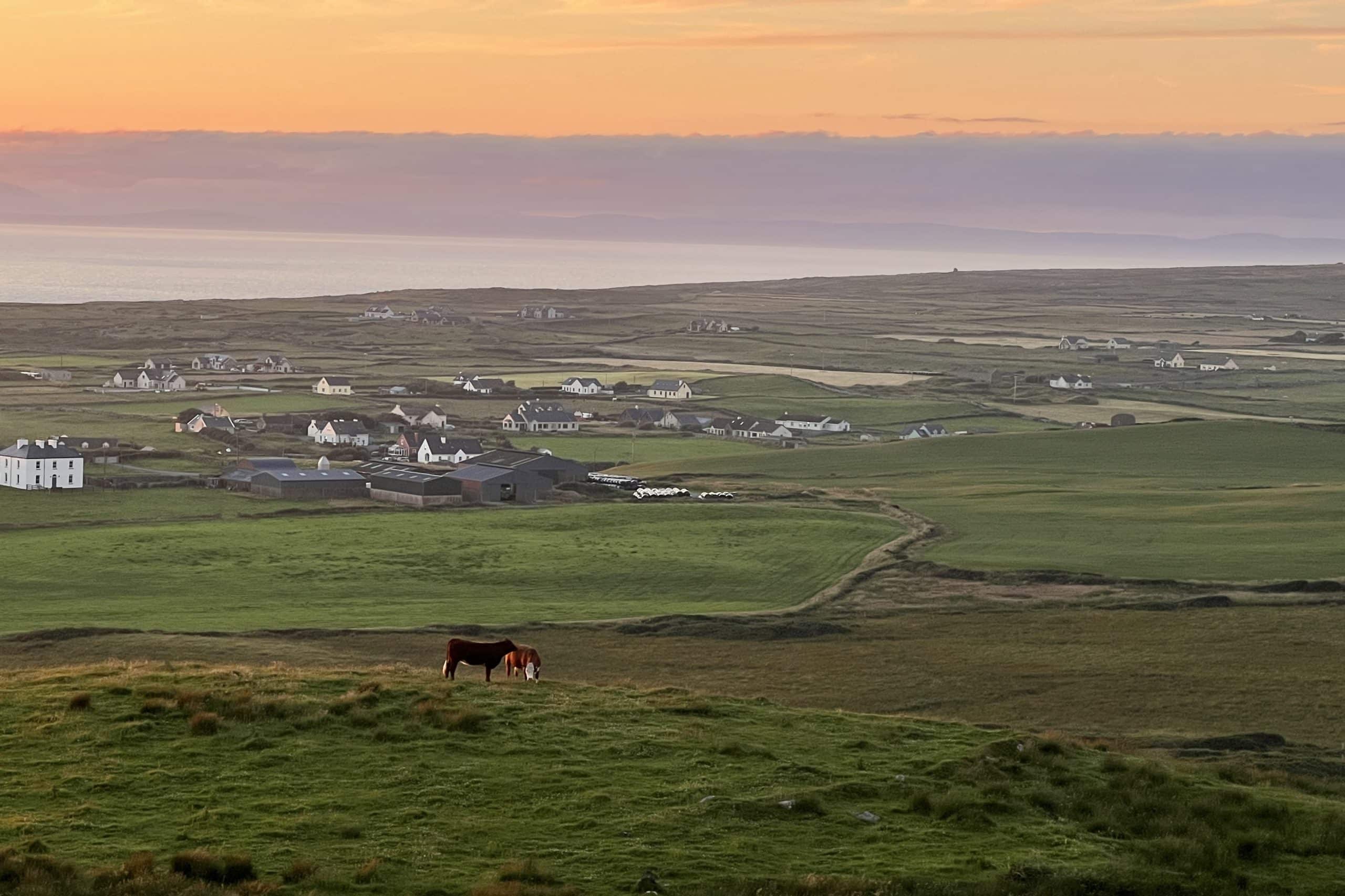
In the north, you can visit the Giant’s Causeway, some Game of Thrones filming sites, and the city of Belfast, home to one of the largest Titanic exhibits.

In the east is the urban city of Dublin, home to Guinness. In Dublin, you’ll find plenty of lively bars and distilleries.

In the south is the town of Cork, known for its fine dining and the famous Blarney Castle.
In the west, you can drive along the scenic Ring of Kerry, visit a coastal town, hike around the Aran Islands, or climb Skellig Michael. Parts of the Star Wars movies The Force Awakens and The Last Jedi were filmed at Skellig Michael.

A little further north from here, one can continue onward to the heritage village of Adare, before heading to the Cliffs of Moher. Alternatively, head inland to explore the laidback town of Killarney.
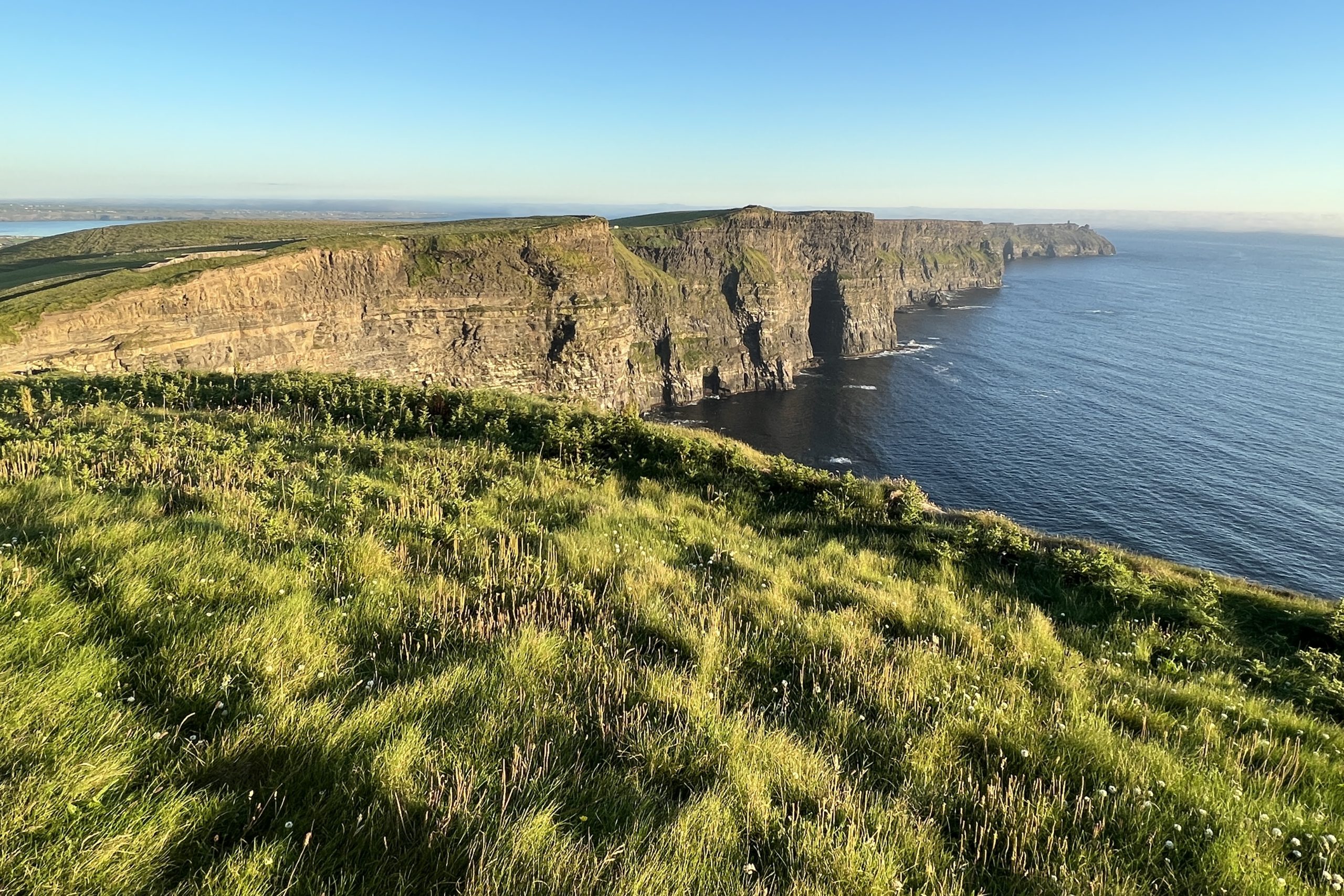
When considering Ireland, there are a couple of things to be aware of.
The first is that there’s a lot to see and do beyond Dublin. Since attractions are fairly spread out, you’ll likely have to do a lot of driving from one place to another.
If your kids don’t do well with long car rides, plan your stops accordingly.
Even after 11 nights, we only saw about half of what we wanted to. So if you only have a week to explore Ireland, I’d suggest focusing on one region.
Another consideration is the weather. Irish weather can be very unpredictable, and you can even experience three seasons in a single day.
Come prepared to encounter sun, rain, and wind, with the days tending to be warm and the evenings quite cool.
The Flights
Multiple carriers offer flights to Ireland from Canada. Some routes operate year-round, while others are seasonal.

- Air Canada offers direct flights from Toronto, Montreal and Vancouver.
- WestJet offers direct flights from Calgary and Toronto.
- Aer Lingus and Air Transat both offer direct flights from Toronto.
There are often flight sales to Dublin, especially in the shoulder seasons, with a round-trip flights costing just over $400–$500 from Toronto. If you can find a good price, it may be worth saving your points and paying cash instead.

We travelled during peak season, so a round-trip ticket went for $750 when booking four to six months out. Closer to the date, however, tickets priced out at around $1,200 with Air Canada.
Aer Lingus
In the past, redeeming Aer Lingus flights through British Airways Avios used to be a great sweet spot. Off-peak or peak pricing came out at 13,000 or 20,000 Avios one-way in economy, or 50,000 or 60,000 Avios in business class from Toronto or Montreal, with taxes and fees of around $90.
You could also reliably find up to five award seats in economy, which made it a feasible redemption for families.
Unfortunately, the taxes and fees have since increased to over $200 per person one-way in economy and over $575 in business class. The taxes alone could pay for a cash fare in economy during a seat sale!
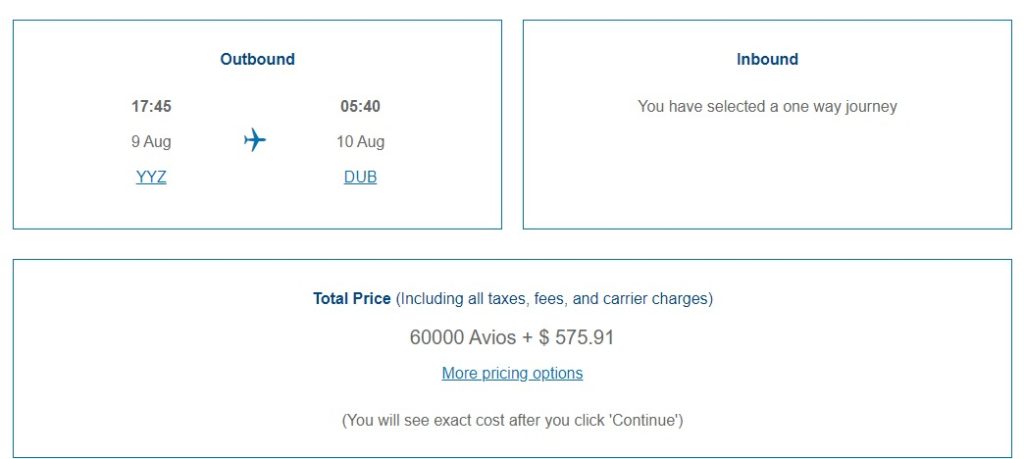
My parents wound up booking on Aer Lingus using Avios, as they were able to secure their flights before the increase in taxes. Their onboard experience, however, wasn’t the greatest.
They felt the economy cabin was more cramped than on Air Canada. Furthermore, only a small snack was served during the flight, and it felt quite muggy on the plane.
Air Canada
My family went with an Aeroplan redemption from Toronto to Dublin. Normally, an Economy (Standard) ticket starts around 30,000 Aeroplan points one-way.
Since every seat with Air Canada is available on Aeroplan, finding seat availability for a family is rarely an issue. With dynamic pricing, though, the pricing may not always be optimal.
We booked Economy (Latitude) tickets for 48,100 Aeroplan points and $60 in taxes and fees per person for our one-way flight to Dublin. Using the “Latitude Attitude“, we then used our eUpgrades to get into business class.
For a seven-hour overnight flight, I thought this was well worth the cost.
WestJet
Coming back, we could have made a similar redemption, but since it was a daytime flight, I felt that flying economy would be fine. We saved our Aeroplan points and went with WestJet instead, as I had a WestJet gift card from an RBC mortgage promotion a few years ago and some WestJet Dollars to burn.
Our one-way flight back cost $395.59 per person.
If you have plenty of WestJet Dollars at your disposal and want to fly more comfortably, WestJet sometimes has decent Member Exclusive fares for premium tickets. If you can catch a deal, it may not be too much more than an economy fare.
Connecting Flights
If you want to focus on just western Ireland, consider booking a connecting flight into one of Ireland’s smaller airports.
Connecting flights can be made to Shannon (SNN) to Kerry (KIR) on Ryanair. This will spare you from three or four hours in a car from Dublin.
Cars can be rented from either airport.
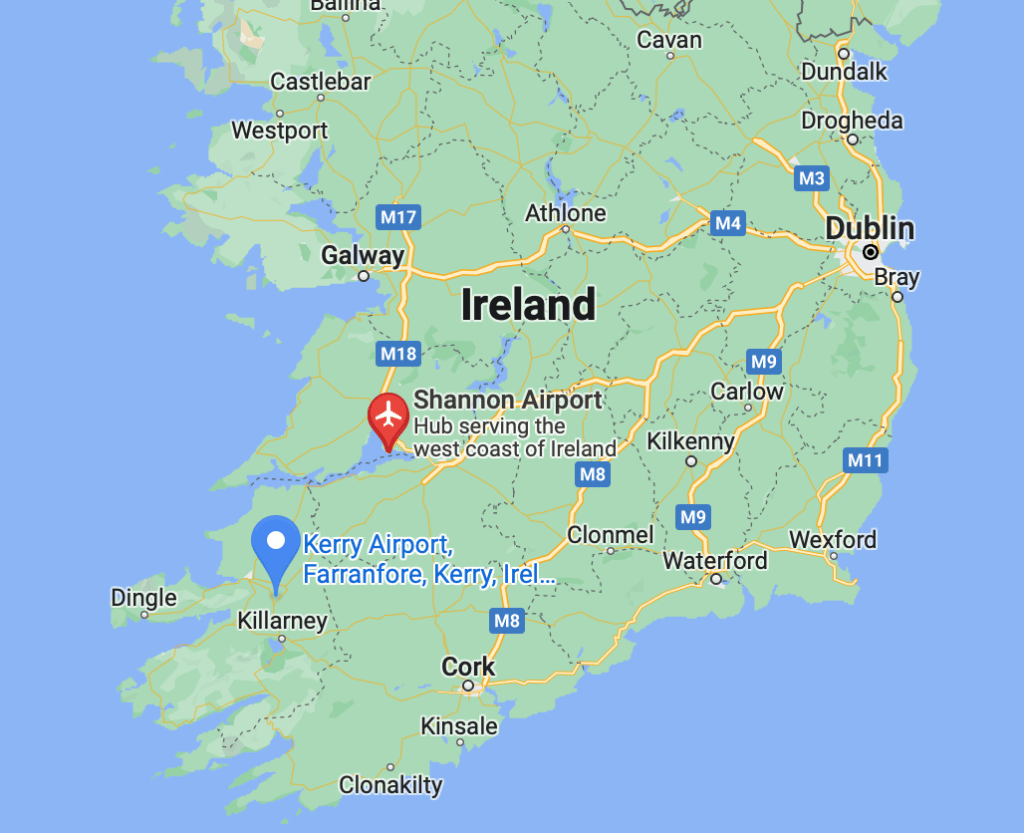
Since my parents and sister were flying in to join us part way into our trip, they actually met us at Shannon and Kerry, which worked out nicely.
The Itinerary
For our 12 nights in Ireland, we split it up as follows:
- Four nights in Killarney
- One night in Adare
- Two nights in Doolin
- Two nights in Dublin
- Two nights in Belfast
- One night near the Dublin airport catch our return flight
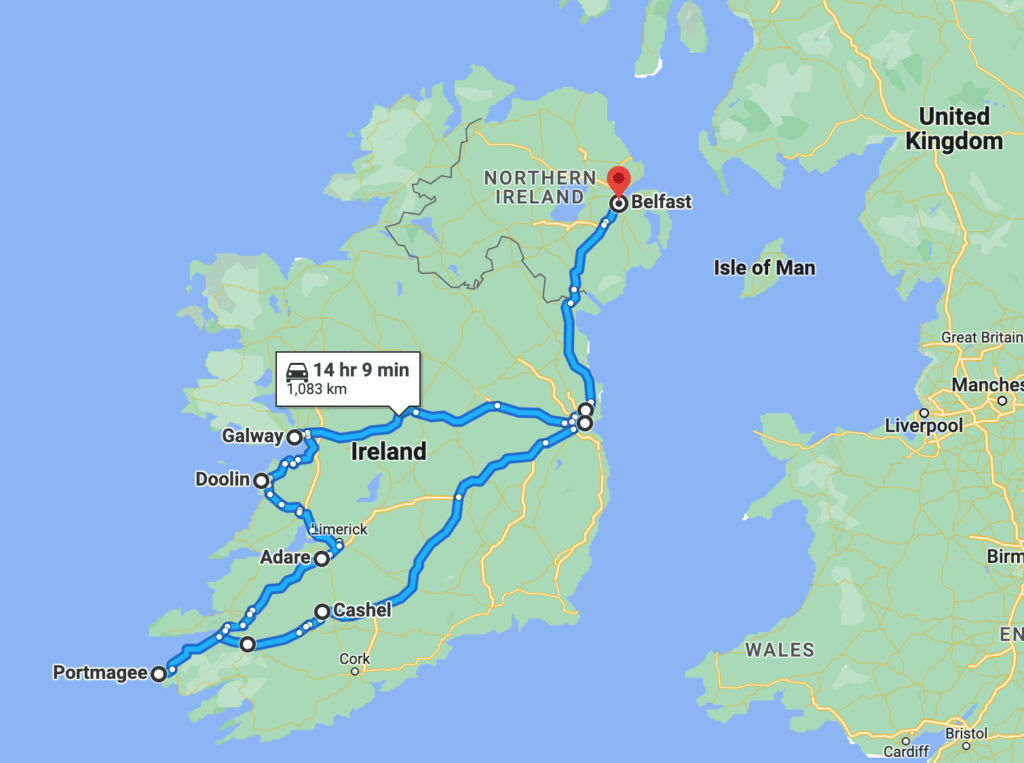
We covered quite a bit of distance during our stay. If I were to do it again, I’d reverse the itinerary, as the more relaxing part of the trip was in Killarney and Adare, followed by Doolin.
Our time in Dublin and Belfast was a bit rushed, and we could have used at least another night in each location.
We also didn’t get a chance to visit Cork in the southern part of Ireland, which is known for its fine food. If you only have a week, I’d recommend limiting yourself to either Eastern Ireland or Western Ireland, and maybe save a day for the south.
Car Rentals and Driving in Ireland
Driving in Ireland wasn’t an issue at all; however, beware that many of the roads outside the main cities are quite narrow. Some have only a single lane for two-way traffic.
Furthermore, driving is on the opposite side of the road to North America, and drivers sit on the right-hand side of the car.
We rented our vehicle from Hertz at the Dublin Airport. We were quite limited in what we could rent, as we had a total of nine people travelling together.
We ended renting a Renault Trafic for a week for €1,062.96 ($1,400 CAD) on the Car & Driver rate. We have a subscription that only costs $20 for the year, and without the code, the cost would have been double!
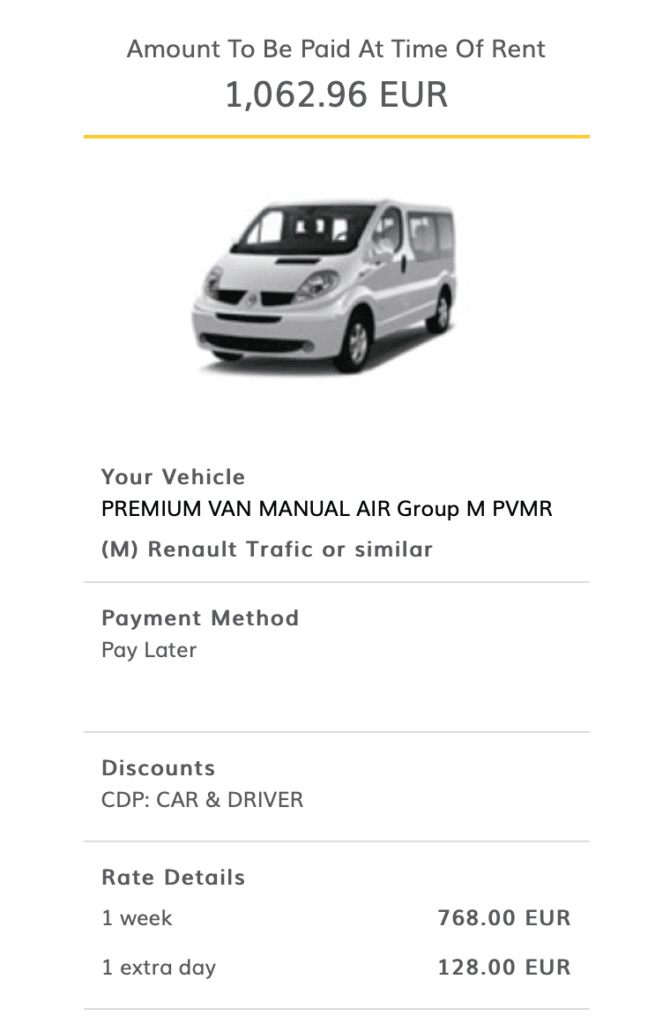
The Trafic was very spacious and comfortably fit all nine of us. There was also plenty of trunk space to fit all our luggage, too.
I admit that I was a bit worried about driving it on the small, narrow roads, but we managed just fine.
For a smaller family, a smaller SUV would probably suffice, and can be rented for much cheaper. I found the American Express Platinum Card rate to be pretty good for this vehicle class.
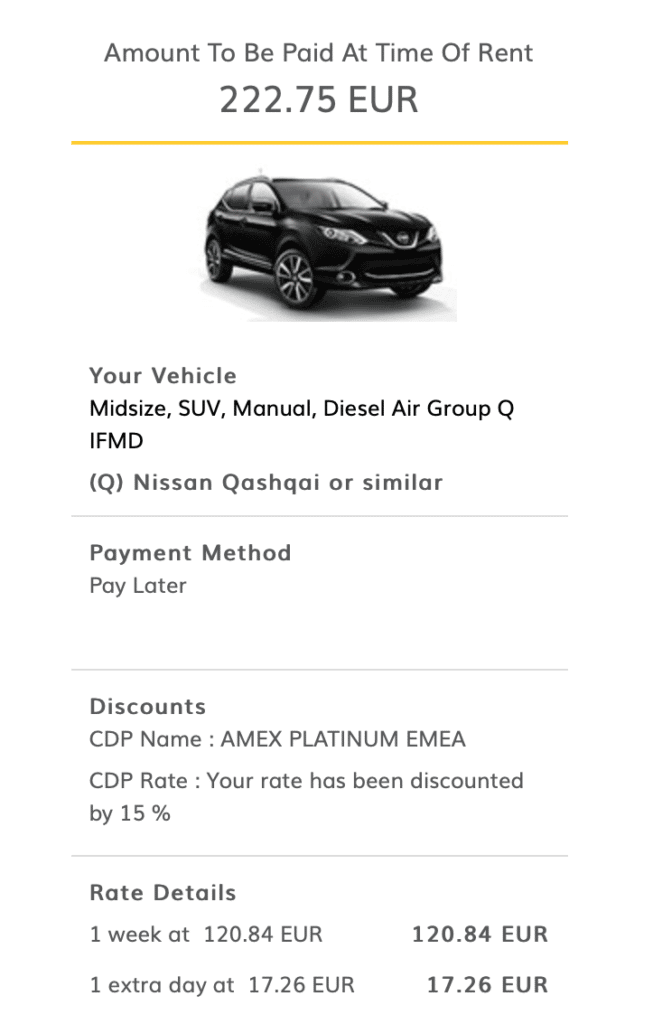
I usually decline the insurance coverage offered by car rental agencies, as we have coverage with the Amex Platinum Card. However, if you read the fine print, there are some vehicle classes that are excluded from coverage, including any vehicle larger than a minivan.
Other credit card insurance policies often have similar exclusions, so read your policy carefully before declining coverage.
If you’re relying on your credit card insurance, then be sure to have a hard copy letter from the credit card insurer stating that your coverage extends to both the Republic of Ireland and Northern Ireland. Apparently, most car rental companies in Ireland require this.
All it takes is a 10-minute phone call to the insurer to get the letter emailed to you.
Buses
Another option for getting to and from other larger cities in Ireland is by bus. Buses are a comfortable alternative to a car rental if you want to cut down on driving, but the destinations served are rather limited.
Buses can be a great way to get to a major city, and from there, if needed, you can rent a car to get around to the smaller towns and attractions.
We saved ourselves a few days of renting a car by taking the bus from Dublin to Belfast, booked with Aircoach for €14 ($18 CAD) per adult and €9 ($12 CAD) per child.

Coming back from Belfast, we booked a bus that took us directly to the airport in Dublin through Translink, for £9.50 ($15 CAD) per adult and £5.70 ($9 CAD) per child. Booking online beforehand saves you a bit compared to paying at the bus station.
Conclusion
Ireland is a beautiful country with somewhat unpredictable weather. Summer is the best time to go to maximize your chance of having good weather.
It’s a relatively easy destination to get to from Canada, and you can usually score a good deal with cash or points. Once there, travelling within Ireland is quite simple, although some cities and attractions are far apart.
Stay tuned for the next several articles in this series on our holiday. I’ll cover what we did, where we stayed in Dublin, Belfast, Killarney, and Doolin, and finally, our one-night splurge in an Irish castle.

















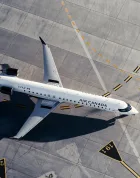


Fabulous advice and what an awesome adventure! How did you do the latitude attitude for 5 people? Maybe I’m not remembering the correct number of kids… I have 2 kids so I definitely appreciate your posts!!